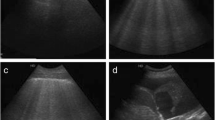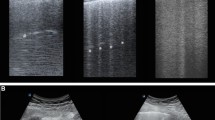Summary
Objective
The aim of this study was to describe real world extravascular lung water index (EVLWI) measurements obtained by pulse index continuous cardiac output (PiCCO) on the day of admission. These were then related to a radiologic score for lung edema, Halperin score and both the Halperin score and EVLWI were assessed for prediction of in-hospital mortality in critically ill patients.
Methods and results
A total of 311 patients admitted to a tertiary medical university hospital between February 2004 and December 2010 were included in this retrospective analysis and of these 177 patients were intubated. In-hospital mortality was assessed by logistic regression. In the overall cohort, EVLWI and the Halperin score correlated poorly (r = 0.17; p = 0.02). In intubated patients, EVLWI and Halperin score did not correlate (r = 0.09; p = 0.39), whereas in patients who were not intubated there was a moderate association (r = 0.30; p = 0.007).
In the overall cohort, (a) EVLWI (hazard ratio [HR] 1.10, 95% confidence interval [CI] 1.02–1.19; p = 0.01; area under the curve [AUC] 0.63, 95% CI 0.54–0.71) but not (b) Halperin score (HR 1.00, 95% CI 0.996–1.004; p = 0.94; AUC 0.52, 95% CI 0.45–0.58) was associated with in-hospital mortality There was a robust association of EVLWI (HR 1.12, 95% CI 1.01–1.25; p = 0.03) but not Halperin score (HR 1.003, 95% CI 0.997–1.009; p = 0.30) with mortality in non-intubated patients. In intubated patients, neither EVLWI (HR 0.997 95% CI 0.990–1.003; p = 0.33) nor Halperin score (HR 1.08; 95% CI 0.88–1.32; p = 0.47) was associated with mortality.
Conclusion
The EVLWI correlated moderately with a radiologic score for lung edema, the Halperin score, in non-intubated but not in intubated patients. The EVLWI at admission was associated with in-hospital mortality in our patient collective of critically ill patients and might constitute not only a tool for risk stratification but most importantly a valuable treatment goal.


Similar content being viewed by others
Abbreviations
- CO:
-
Cardiac output
- CVP:
-
Central venous pressure
- EVLWI:
-
Extravascular lung water index
- GEDVI:
-
Global end-diastolic volume index
- ICU:
-
Intensive care unit
- ITBVI:
-
Intrathoracic blood volume index
- PAC:
-
Pulmonary artery catheter
- PICCO:
-
Pulse index continuous cardiac output
- SVRI:
-
Systemic vascular resistance index
References
Swan HJ, Ganz W, Forrester J, Marcus H, Diamond G, Chonette D. Catheterization of the heart in man with use of a flow-directed balloon-tipped catheter. N Engl J Med. 1970;283(9):447–51. https://doi.org/10.1056/nejm197008272830902. Epub 1970/08/27.
Kirton OC, Calabrese RC, Staff I. Increasing use of less-invasive hemodynamic monitoring in 3 specialty surgical intensive care units: a 5-year experience at a tertiary medical center. J Intensive Care Med. 2015;30(1):30–6. https://doi.org/10.1177/0885066613498055. Epub 2013/08/14.
Wernly B, Lichtenauer M, Franz M, Fritzenwanger M, Kabisch B, Figulla HR, et al. Pulse contour cardiac output monitoring in acute heart failure patients : assessment of hemodynamic measurements. Wien Klin Wochenschr. 2016;128(23/24):864–9. https://doi.org/10.1007/s00508-016-1048-z. PubMed PMID: 27525745; PubMed Central PMCID: PMCPMC5161758.
Ritter S, Rudiger A, Maggiorini M. Transpulmonary thermodilution-derived cardiac function index identifies cardiac dysfunction in acute heart failure and septic patients: an observational study. Crit Care. 2009;13(4):R133. https://doi.org/10.1186/cc7994. Epub 2009/08/13.
Oren-Grinberg A. The PiCCO Monitor. Int Anesthesiol Clin. 2010;48(1):57–85. https://doi.org/10.1097/AIA.0b013e3181c3dc11. Epub 2010/01/13.
Litton E, Morgan M. The PiCCO monitor: a review. Anaesth Intensive Care. 2012;40(3):393–409. Epub 2012/05/15.
Cottis R, Magee N, Higgins DJ. Haemodynamic monitoring with pulse-induced contour cardiac output (PiCCO) in critical care. Intensive Crit Care Nurs. 2003;19(5):301–7. Epub 2003/10/01.
Jozwiak M, Silva S, Persichini R, Anguel N, Osman D, Richard C, et al. Extravascular lung water is an independent prognostic factor in patients with acute respiratory distress syndrome. Crit Care Med. 2013;41(2):472–80. https://doi.org/10.1097/CCM.0b013e31826ab377. Epub 2012/12/25.
Kuzkov VV, Kirov MY, Sovershaev MA, Kuklin VN, Suborov EV, Waerhaug K, et al. Extravascular lung water determined with single transpulmonary thermodilution correlates with the severity of sepsis-induced acute lung injury. Crit Care Med. 2006;34(6):1647–53. https://doi.org/10.1097/01.ccm.0000218817.24208.2e. Epub 2006/04/21.
Wang ZY, Bai Y. Extravascular lung water and pulmonary vascular permeability index may inadvertently delay the identification of acute respiratory distress syndrome. Crit Care. 2013;17(2):420. https://doi.org/10.1186/cc12542. PubMed PMID: 23522053; PubMed Central PMCID: PMCPMC3672491.
Wang H, Cui N, Su L, Long Y, Wang X, Zhou X, et al. Prognostic value of extravascular lung water and its potential role in guiding fluid therapy in septic shock after initial resuscitation. J Crit Care. 2016;33:106–13. https://doi.org/10.1016/j.jcrc.2016.02.011. PubMed PMID: 27021852.
Gassanov N, Caglayan E, Nia A, Erdmann E, Er F. Hemodynamic monitoring in the intensive care unit: pulmonary artery catheter versus PiCCO. Dtsch Med Wochenschr. 2011;136(8):376–80. https://doi.org/10.1055/s-0031-1272539. PubMed PMID: 21332037.
Halperin BD, Feeley TW, Mihm FG, Chiles C, Guthaner DF, Blank NE. Evaluation of the portable chest roentgenogram for quantitating extravascular lung water in critically ill adults. Chest. 1985;88(5):649–52. PubMed PMID: 3902385.
Knaus WA, Zimmerman JE, Wagner DP, Draper EA, Lawrence DE. APACHE-acute physiology and chronic health evaluation: a physiologically based classification system. Crit Care Med. 1981;9(8):591–7. Epub 1981/08/01.
Le Gall JR, Lemeshow S, Saulnier F. A new simplified acute physiology score (SAPS II) based on a European/north American multicenter study. J Am Med Assoc. 1993;270(24):2957–63. Epub 1993/12/22.
Mutoh T, Kazumata K, Ajiki M, Ushikoshi S, Terasaka S. Goal-directed fluid management by bedside transpulmonary hemodynamic monitoring after subarachnoid hemorrhage. Stroke. 2007;38(12):3218–24. https://doi.org/10.1161/strokeaha.107.484634. Epub 2007/11/10.
Author information
Authors and Affiliations
Corresponding author
Ethics declarations
Conflict of interest
B. Wernly, S. Haumann, M. Masyuk, J. Muessig, M. Lichtenauer, L. Bäz, M. Franz, A. Pfeil, A. Lauten, P.C. Schulze, U.C. Hoppe, M. Kelm, R. Westenfeld, C. Jung, and D. Renz declare that they have no competing interests.
Ethical standards
The study was approved by the local ethics committee of Jena University Hospital and the Medical Faculty of the Friedrich Schiller University of Jena. The local ethics committee of Jena University Hospital waived the need to obtain written informed consent to participate from the patients involved in this study, as the data were collected retrospectively.
Additional information
Availability of supporting data
All data relevant for this study will be given by the authors upon specific request without restriction.
Rights and permissions
About this article
Cite this article
Wernly, B., Haumann, S., Masyuk, M. et al. Extravascular lung water index and Halperin score to predict outcome in critically ill patients. Wien Klin Wochenschr 130, 505–510 (2018). https://doi.org/10.1007/s00508-018-1370-8
Received:
Accepted:
Published:
Issue Date:
DOI: https://doi.org/10.1007/s00508-018-1370-8




